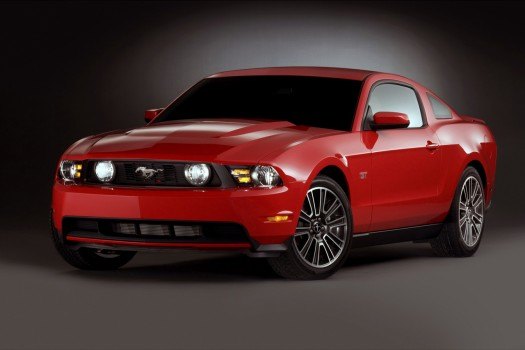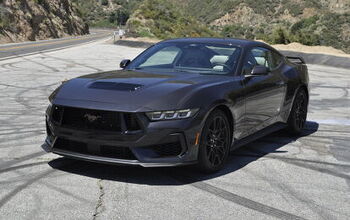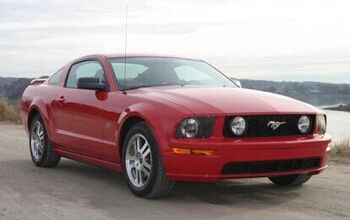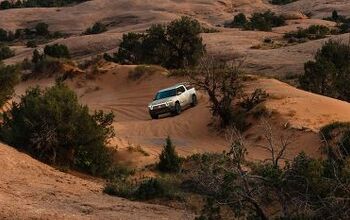2010 Ford Mustang GT Review
It’s easy to have mixed feelings about the 2005-2009 Mustang GT. It’s handsome, for the money you paid you got pretty good V8 power and it was fast enough. Where the (suddenly) last-gen Mustang falls down is the lowest bidder interior, questionable handling and non-track day brakes. “Listen baby I had a great time, but don’t lose any sleep sitting by the phone.” But hey, Ford’s prepped a (kinda) all new steed for 2010 and you can bet Mullally’s golden ‘chute that Mustang engineers have been hard at work addressing the above issues. Well, except for the brakes.
If you have an internet connection and a passing interest in cars, you’ve already sick of seeing the redesigned ‘Stang. But in person, it’s much better looking than in 2D. The detail that struck me hardest were the three creases on the hood. It’s an intriguing, complex surface. The side mirrors are painted body color (yay!) and the antennae has been moved to the rear. And you know, I like the more geometric rear end with the three-bar taillights. I also like the resculpted face. Sure it has some Camaro cues (hooded lights, downhill curve) but they’re good cues and segment appropriate. The only body panel they didn’t change is the roof, but sitting on the fatter (er, more muscular) haunches it reminds me even more of the ’68 Fastback. Which is good. And you really got to see this baddie in Grabber Blue.
Ford got halfway to the promised land with the interior. Gone are many of the more egregious examples of IQ insulting penny pinching. For instance the bulk of the dash is now covered in actual aluminum. The gauges are not only crisper but Mustang exclusive. The leather seats sport oversized, contrast stitching and a stylish accent stripe. But there’s hardly any bolstering and after more than an hour, they hurt your back. Another example of almost but not quite: Ford placed soft leather inserts into the doors. Nice. But above ’em is the same lousy plastic as last year. Pity.
Put your foot into the throttle and you’ll bang your head (against the headrest). Power is up for 2010. Up to Bullitt levels. That’s 315 hp and 325 lb-ft of torque. And check this: should you choose to fill up with premium gas, the ECU makes the torque earlier between 1,000-3,000 rpm. Also like the Bullitt, engine noise is piped into the cabin. Literally. While the sound isn’t quite as sweet as the car McQueen inspired (blame thicker sound proofing), the grunt is better than before. 0-60 times are probably in the 5 second flat range, just like the Bullitt. In certain interior packages, you can even shift gears with the Bullitt’s knob. If you’ve guessed that Ford benchmarked the Bullitt when designing the new car, pat yourself. Why? The Bullitt was the best Mustang Ford ever built.
The Bullitt made great strides in addressing the standard car’s handling issues. The 2010 Mustang GT crosses the finish line. More bracing, tighter spring rates, more damping, thicker sway bars and greatly improved aerodynamics work together to create the first Mustang in memory that thrives in the twisty stuff. Stick your head between the mufflers and you’re still greeted by a thick live axle. Ready for the truth: so what? After seven hours of constant, aggressive driving I encountered exactly one patch of asphalt that upset the rear end. But it was so cruddy that an IRS car would’ve spazzed, too.
I took the GT up and over some of the most challenging, technical canyon roads Southern California has to offer. The new ‘Stang excelled. I could go hard into essentially every corner and confidently blast my way out (some of the uber tight, near-180 degree guys require a soft entry). Like wow, man — a Mustang that’s actually confidence inspiring on windy roads. The steering is a bit over-boosted and the 19” wheels could use souped up tires, but I’m splitting hairs. Finally we have a Mustang that handles the way every 14-year-old assumes it does. Except for those brakes…
Instead of being an also-ran, value proposition in need of lots-o-mods, the “evolution not revolution” 2010 Mustang is a good performance car right out of the box. For those requiring a bit more brawn, there’s the $1,400 Track Pack that gives you Pirelli P Zeros, stiffer shocks and sways — plus upgraded brakes. The real question though, is whether you should buy a Bullitt right now for several grand off sticker, or wait a month and grab the 2010 Mustang. Probably at full price ($27,000 or so). Tough choice. If forced, I’d say that the Bullitt sounds better whereas the new GT drives better. Meaning this is the best Mustang ever. For now at least.
[Jonny Lieberman attended a manufacturer’s press event. Ford paid for gas, insurance, food and one night of hotel accommodations]
Latest Car Reviews
Read moreLatest Product Reviews
Read moreRecent Comments
- SCE to AUX 08 Rabbit (college car, 128k miles): Everything is expensive and difficult to repair. Bought it several years ago as a favor to a friend leaving the country. I outsourced the clutch ($1200), but I did all other work. Ignition switch, all calipers, pads, rotors, A/C compressor, blower fan, cooling fan, plugs and coils, belts and tensioners, 3 flat tires (nails), and on and on.19 Ioniq EV (66k miles): 12V battery, wipers, 1 set of tires, cabin air filter, new pads and rotors at 15k miles since the factory ones wore funny, 1 qt of reduction gear oil. Insurance is cheap. It costs me nearly nothing to drive it.22 Santa Fe (22k miles): Nothing yet, except oil changes. I dread having to buy tires.
- AZFelix 2015 Sonata Limited72k when purchased, 176k miles currentlyI perform all maintenance and repairs except for alignment, tire mounting, tire patching, and glass work (tint and passenger left due to rock hit). Most parts purchased through rockauto.com.Maintenance and repairs during three years of ownership:Front rotors and all brake pads upgraded shortly after purchase.Preparing for 17th oil change (full synthetic plus filter c.$50), one PCV valve.Timing & accessory belts, belt tensioner.Coolant full flush and change.Fibrous plastic material engine under tray replaced by aftermarket solid plastic piece $110.One set of tires (c.$500 +installation) plus two replacements and a number of patches due to nails, etc. Second set coming soon.Hood struts $30.Front struts, rear shocks, plus sway bar links, front ball joints, tie rod ends, right CV axle (large rock on freeway damaged it and I took the opportunity to redo the rest of items on this list).Battery c.$260.Two sets of spark plugs @ $50/set.Three sets of cabin and engine filters.Valve cover gasket (next week).Averages out to c.$1400 per year for the past three years. Minor driver seat bolster wear, front rock chips, and assorted dents & dings but otherwise looks and drives very well.
- 3-On-The-Tree 2014 Ford F150 Ecoboost 3.5L. By 80,000mi I had to have the rear main oil seal replaced twice. Driver side turbo leaking had to have all hoses replaced. Passenger side turbo had to be completely replaced. Engine timing chain front cover leak had to be replaced. Transmission front pump leak had to be removed and replaced. Ford renewed my faith in Extended warranty’s because luckily I had one and used it to the fullest. Sold that truck on caravan and got me a 2021 Tundra Crewmax 4x4. Not a fan of turbos and I will never own a Ford again much less cars with turbos to include newer Toyotas. And I’m a Toyota guy.
- Duke Woolworth Weight 4800# as I recall.
- Kwik_Shift_Pro4X '19 Nissan Frontier @78000 miles has been oil changes ( eng/ diffs/ tranny/ transfer). Still on original brakes and second set of tires.











































Comments
Join the conversation
I'll weigh in. I drove a Camry rental car once (but only once). It was a horrid car. It was large, spacious, handled badly (constant torque steer or understeer, tendency to dart left or right rather than go straight) and basically had no soul. There was nothing there to make me want the car. Of course, Camry people are going to say I needed to have bought one new, and I guess it is a valid argument, but this car was nearly new with only 600 miles or so on it. It can't have been that messed up. I've had literally thousands of miles in the various big rear-drive Fords. I'd rather a Caprice or Roadmaster for my time, but the big rear-drive fords handle reasonably well, carry a lot, seem to have fewer stupid problems in general due to their simplicity, and have provided excellent value if you don't care too much about fuel mileage. That being said, I drive the last big, useful body-on-frame vehicle, the Chevrolet Suburban. I bought it for a lot of the same reasons people bought the old rear-drive sedans and wagons, which include simplicity, reliability, longevity and carrying capacity. The rear-drive sedans and wagons went away not due to the smaller imports but due to the fact that you can get nearly that level of fuel efficiency out of a much larger body-on-frame SUV, with a half-ton of carriage and (in my case) 7400 pounds towing. So, I'll guess I'll end by saying the Camry and the Crown Vic (and the Caprice, et. al.) were never in the same market segment, so arguing if one was better than the other is arguing at cross purposes. However, if you compare the Camry to the new Malibu or to the Mazda6, it's a very different story, in which the Camry comes out looking like the bland pile of metal it actually is.
The 2011-2012 mustang GT is supposed to be slated with a new 5.0L with 400HP and 400lb-ft of torque. The v6 is supposed roughly the same as the 2010 Taurus SHO with the 3.5L turbo with 360 horsepower. The new 5.0L powerplant has a codename of Coyote. Just google new Ford 5.0L and you will find it. By the way the 2010 mustang that is reviewed here does a 0-60 in 4.9 seconds with the track package. That's over a half second faster than the Evo and the hyundai genesis coupe. The mustang isn't fat weighing in at 3550 pounds fully loaded with all the electronic crap they offer. It's at least 300 pounds ligter than the camaro ss and 400 pounds lighter than the challenger srt8. All youd need to do is drop 300 dollars on a short throw shifter and another 300 on a tuner and you can say goodbye to both the challenger and camaro.